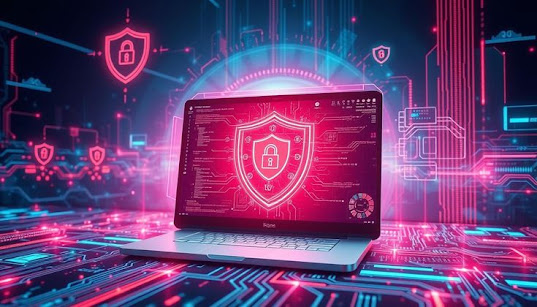Can AI Defend Against AI-Powered Malware? The Battle of Intelligent Code in 2025
Can AI Defend Against AI-Powered Malware? The Battle of Intelligent Code in 2025
In today’s world, Artificial Intelligence isn’t just changing the way we work, talk, and live—it’s also transforming the world of cybersecurity. But with AI now used by both defenders and attackers, we’re facing a serious question in 2025:
Can AI truly defend against AI-powered malware?
This is no longer a future scenario—it’s happening right now. Security tools are getting smarter, but so are the threats they’re built to fight. In this blog, we’ll dive deep into the evolving AI vs AI battlefield, exploring how hackers are using AI to create dangerous malware—and how defenders are responding using their own intelligent systems.
1. Understanding AI-Powered Malware: A New Breed of Threat
Traditional malware was built with static code, signature patterns, and limited decision-making power. But today’s AI-powered malware is different.
It can adapt, hide, and learn from its environment. Imagine a piece of malicious code that detects it’s being watched by antivirus software—and then changes its behavior to escape detection. That’s not sci-fi; it’s real and growing.
AI-based malware can:
-
Change attack paths in real time
-
Analyze a system before deploying a payload
-
Mimic normal system behavior to stay undetected
-
Learn from failed attacks to try again with different methods
It’s like fighting a shape-shifting enemy that learns from every move you make.
2. How Are Hackers Using AI in 2025?
Cybercriminals are embracing generative AI to build better attacks. Tools like GPT-style models and reinforcement learning are being misused to:
-
Write better phishing emails that sound human and personalized
-
Generate code snippets that can bypass firewalls or scanners
-
Automate social engineering by analyzing social media and crafting convincing scams
-
Create deepfakes for voice authentication or manipulation
One alarming trend is Polymorphic Malware, which constantly rewrites its own code using AI algorithms, making it nearly impossible for signature-based defenses to catch it.
In 2025, many cybercrime operations resemble tech startups—complete with AI developers, testers, and “customer support.” Their products? Scalable, intelligent malware sold to the highest bidder.
3. The Rise of Defensive AI: Smart Shields for Smart Threats
To fight fire with fire, cybersecurity vendors and researchers have built AI-driven defense systems that go beyond traditional antivirus. These new tools don’t just react—they predict, learn, and defend in real-time.
Some key areas where AI is helping:
-
Anomaly detection: Spotting behavior that doesn’t match normal patterns
-
Predictive analytics: Flagging possible threats before they strike
-
Automated incident response: Blocking, isolating, and reporting in milliseconds
-
Natural Language Processing (NLP): Scanning messages and emails for phishing
-
Behavioral biometrics: Using keystroke and mouse movement analysis to detect intrusions
Companies like Darktrace, SentinelOne, and CrowdStrike are leading the way in using machine learning models that monitor vast networks and spot suspicious activity before humans can even notice.
4. Real-Life Case: AI vs. AI in Action
In late 2024, a financial firm in London experienced a unique cyberattack. A phishing email bypassed their spam filters, not because it was lucky—but because it was generated by an AI trained specifically on their employees’ email language.
The malware payload was polymorphic and tested its environment before executing. Fortunately, the firm had a behavioral AI monitoring system, which noticed unusual data access patterns and flagged it.
Within seconds, the AI defense system:
-
Isolated the infected endpoint
-
Alerted the security team
-
Rolled back changes and patched the access loophole
No human intervention was needed in those critical first moments.
This shows how only an AI-powered defense could have countered such an advanced, AI-crafted threat.
5. Strengths of AI in Cyber Defense
Let’s break down why AI is such a powerful ally in cybersecurity:
a. Speed
AI doesn’t sleep. It can process millions of logs per second, far faster than any human.
b. Pattern Recognition
AI models can recognize complex behavior patterns across networks, users, and endpoints—flagging things even seasoned analysts might miss.
c. Scalability
AI defense systems can be deployed across large-scale environments, from small offices to global enterprises.
d. Automation
From threat detection to response, AI can act autonomously, reducing response times from hours to milliseconds.
6. Limitations: Can AI Truly Be Trusted Alone?
As powerful as AI is, it’s not a magic shield.
a. False Positives
AI sometimes flags legitimate actions as threats, overwhelming security teams with noise.
b. Black Box Problem
Many AI models are hard to interpret. Security teams often don’t know why an alert was triggered.
c. Data Dependency
AI’s strength depends on the quality of its training data. Bad or biased data can lead to poor performance.
d. AI Poisoning
Hackers can trick AI systems by feeding them manipulated data, slowly altering their behavior to allow threats through—this is known as model poisoning.
7. The Human-AI Hybrid Model: Best of Both Worlds
Despite its limitations, AI works best when paired with human analysts. This hybrid model brings together:
AI’s speed and detection power
Human logic, context, and judgment
Think of AI as a digital watchdog that barks at every threat—and humans as the ones who decide if it’s really a burglar or just the wind.
Modern SOCs (Security Operation Centers) now rely on this model—letting AI handle the volume while humans focus on high-level decision-making.
8. Future Trends: What’s Coming Next?
Looking ahead, here’s what we can expect in the AI-powered cyber battle of 2025 and beyond:
Federated AI Defense: Organizations will share anonymized data to train joint AI models.
Explainable AI (XAI): New tools will make AI decisions more transparent and easier to trust.
AI vs. AI Sandboxes: Environments where defensive AI can test and learn from attacking AI models.
Offensive AI Regulation: Governments may begin regulating or banning the development of AI malware.
It’s a technological arms race, and staying ahead means constantly innovating.
9. Can We Win the War?
So, can AI truly defend against AI-powered malware?
The short answer is: Yes, but not alone.
AI is essential in defending modern systems—but it's not perfect. The most effective approach is layered security, where AI is combined with traditional tools, threat intelligence, strong policies, and human oversight.
Cybersecurity in 2025 is no longer about building a wall. It’s about building an adaptive, intelligent system that can change shape as fast as the threats attacking it.
10. Final Thoughts: The Battle Has Just Begun
The cybersecurity landscape of 2025 is unlike anything before. AI-powered malware is smarter, stealthier, and faster than ever. But AI-powered defense is also stepping up—learning, adapting, and fighting back in real-time.
Whether you’re a business owner, IT professional, or just someone who wants to stay safe online, the message is clear:
“To defeat intelligent threats, we need intelligent defenses.”
Invest in AI tools, keep systems updated, and remember—no system is 100% secure, but with the right tools and awareness, we can tip the battle in our favor.




Comments
Post a Comment